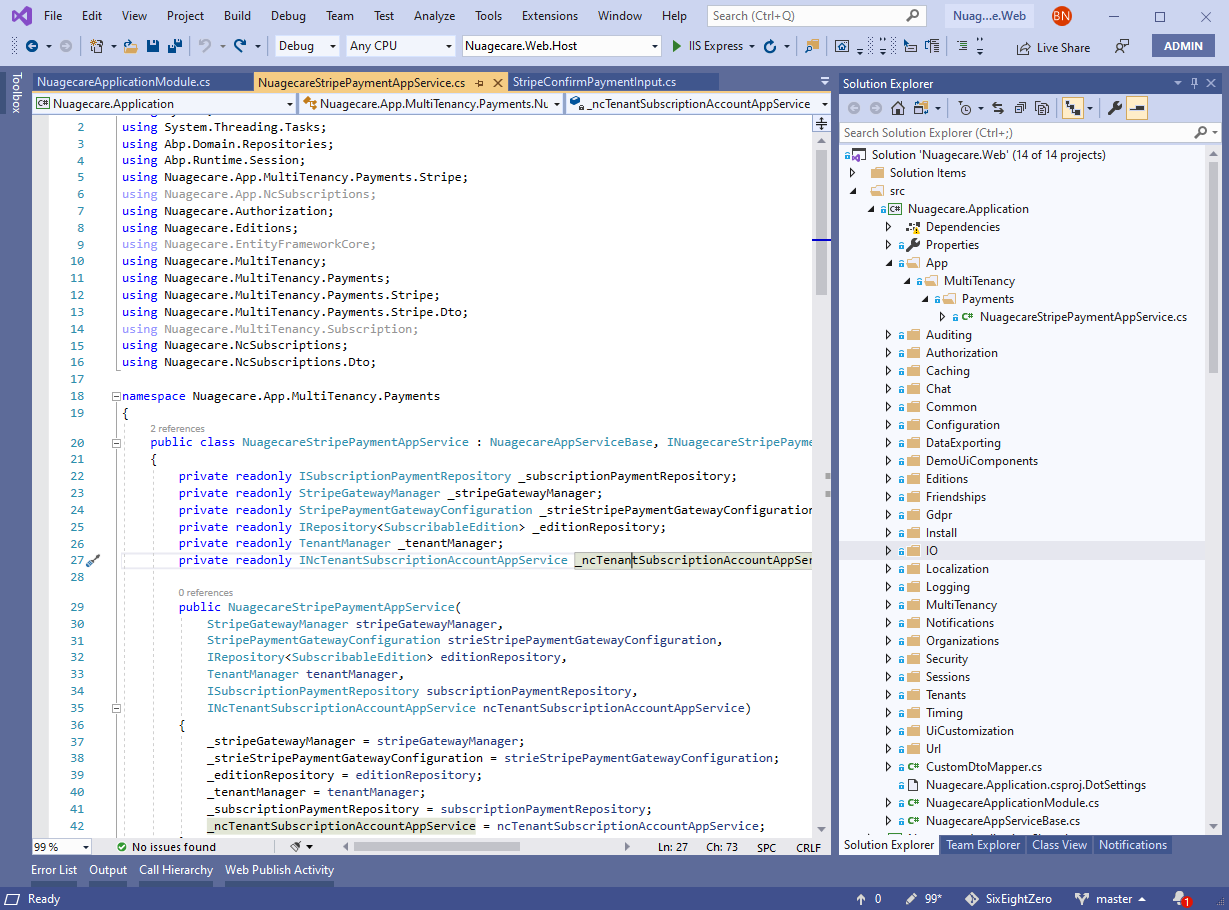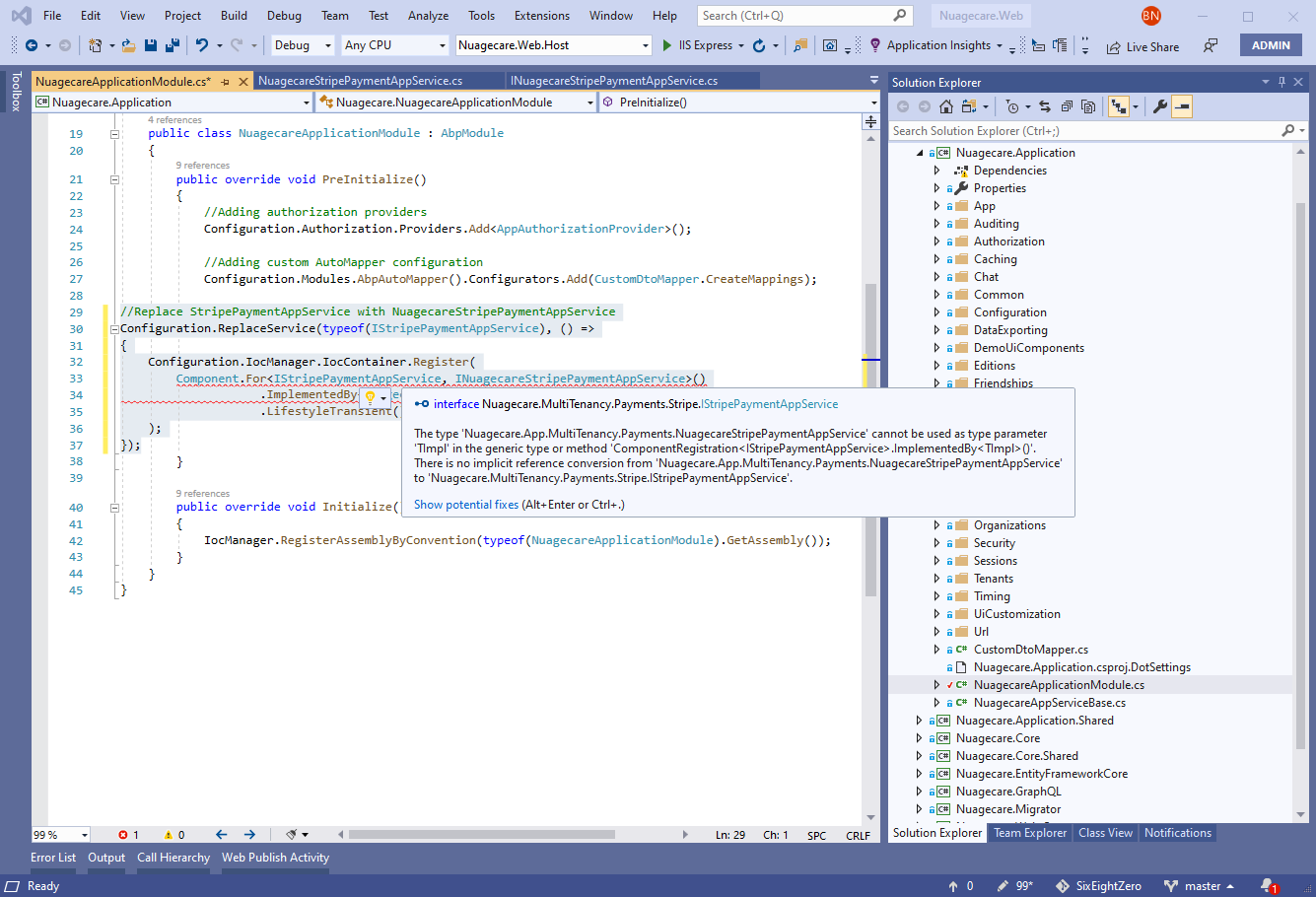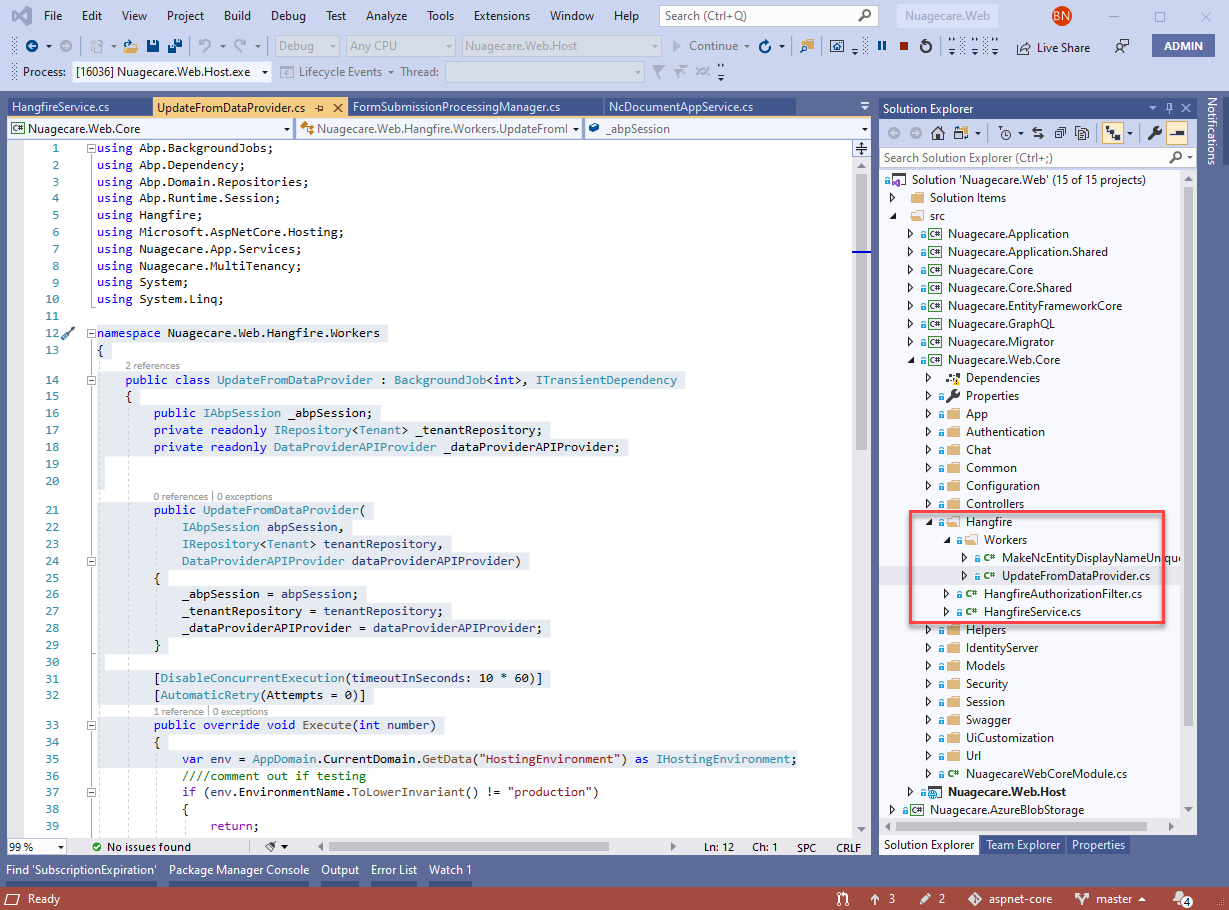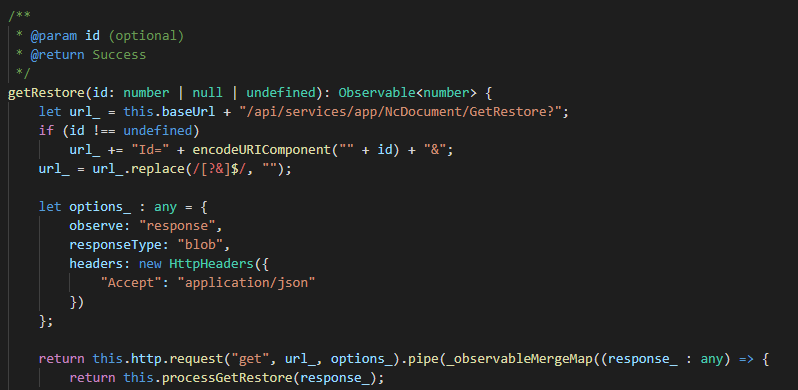.NET Core, Angular, ASPNET Framework 4.6.0, Zero 6.8.0
I want to implement my own StripePaymentAppService.
My conventions are to leave alone the Zero implementation, copy the code and then implement my own.
Create new service: NuagecareStripePaymentAppService, copied from StripePaymentAppService and modified:
 Create new interface, INuagecareStripePaymentAppService, copied direct from IStripePaymentAppService
Create new interface, INuagecareStripePaymentAppService, copied direct from IStripePaymentAppService
 Then, in [ProjectName].Application.[ProjectName]ApplicationModule inject the new service using the following code:
Then, in [ProjectName].Application.[ProjectName]ApplicationModule inject the new service using the following code:
//Replace StripePaymentAppService with NuagecareStripePaymentAppService
Configuration.ReplaceService(typeof(IStripePaymentAppService), () =>
{
Configuration.IocManager.IocContainer.Register(
Component.For<IStripePaymentAppService, INuagecareStripePaymentAppService>()
.ImplementedBy<NuagecareStripePaymentAppService>()
.LifestyleTransient()
);
});
However, I get an error in Visual Studio:
 What am I doing worong and what's best practise here?
What am I doing worong and what's best practise here?
Hi @ismcagdas, yep I have no problem in continuing over there. Makes sense to close the issue and keep the forum tidy.
Hi @ajayak, If you're happy working with Hangfire then stick with Hangfire only. Invoke Hangfire in your WebCoreModule as above. Place your job in the HangfireService:
public class HangfireService
{
public static void InitializeJobs()
{
RecurringJob.AddOrUpdate<ShipmentAddressLocationCoordinatesWorker>(job => job.Execute(0), "50 1 * * 0");
return;
}
}
Then your worker looks something like below. You are trying to run an abp background worker by firing it from Hangfire.
namespace Nuagecare.Web.Hangfire.Workers
{
public class UpdateFromDataProvider : BackgroundJob<int>, ITransientDependency
{
public IAbpSession _abpSession;
private readonly IRepository<Tenant> _tenantRepository;
private readonly DataProviderAPIProvider _dataProviderAPIProvider;
public UpdateFromDataProvider(
IAbpSession abpSession,
IRepository<Tenant> tenantRepository,
DataProviderAPIProvider dataProviderAPIProvider)
{
_abpSession = abpSession;
_tenantRepository = tenantRepository;
_dataProviderAPIProvider = dataProviderAPIProvider;
}
[DisableConcurrentExecution(timeoutInSeconds: 10 * 60)]
[AutomaticRetry(Attempts = 0)]
public override void Execute(int number)
{
var env = AppDomain.CurrentDomain.GetData("HostingEnvironment") as IHostingEnvironment;
... code removed for brevity
Hopefully that shuold be a little clearer.
Here's how it looks in VS.
 Probably the guys at Zero will tell me I have everything wrong!!!!
This has been up and working in an Azure production site for over a year and never fails.
Probably the guys at Zero will tell me I have everything wrong!!!!
This has been up and working in an Azure production site for over a year and never fails.
@ajayak When you use Hangfire it's initialised in your Startup and instantiated in your WebCoreModule, which you probably already know:
if (WebConsts.HangfireDashboardEnabled)
{
//Hangfire(Enable to use Hangfire instead of default job manager)
services.AddHangfire(config =>
{
config.UseSqlServerStorage(_appConfiguration.GetConnectionString("Default"));
HangfireService.InitializeJobs();
});
}
Your HangfireService class triggers jobs using standard CRON scheduling:
public class HangfireService
{
public static void InitializeJobs()
{
RecurringJob.AddOrUpdate<UpdateFromDataProvider>(job => job.Execute(0), "30 * * * *");
return;
}
}
Zero's background jobs work a little differently. They are instantiated into your WebHostModule:
if (IocManager.Resolve<IMultiTenancyConfig>().IsEnabled)
{
var workManager = IocManager.Resolve<IBackgroundWorkerManager>();
workManager.Add(IocManager.Resolve<SubscriptionExpirationCheckWorker>());
workManager.Add(IocManager.Resolve<SubscriptionExpireEmailNotifierWorker>());
}
And the timing is declared at the top of the Worker class:
namespace Nuagecare.MultiTenancy
{
public class SubscriptionExpirationCheckWorker : PeriodicBackgroundWorkerBase, ISingletonDependency
{
private const int CheckPeriodAsMilliseconds = 1 * 60 * 60 * 1000; //1 hour
Hope that helps. Zero's background workers and Hangfire workers can work, it's not one or the other, it can be both.
This one's for @ismcagdas. You mentioned Metronic 7 is due. Do you have any timescales for this before I pour resource in getting to 8.2? Also, they now have 30 demos with "more coming soon", is @hilkakan going to demand that all of these demos are included in the new version ;-)
Hi @demirmusa, now I understand - I have always used Hangfire for my background jobs so took me a little while to figure out how the Zero implementation works. Now I can see it, thanks to your help.
Thanks, @maliming. I will carry out the necessary changes in the AppSettingsProvider.
In my SettingsProvider I want to be able to set a default value from a variable, tenancyName:
new SettingDefinition(
name: NuageSettings.NuageTenantManagement.DocumentationContainer,
defaultValue: GetTenantName(),
scopes: SettingScopes.Tenant,
displayName: null,
description: null,
group: null,
isVisibleToClients: true,
isInherited: true,
customData: null),
Now, I have tried implementing a private method at the foot of the SettingsProvider called GetTenantName() but there is actually no way to return the tenancy name using the TenantManager synchronously. SettingDefinitions are returned using a synchronous method:
public override IEnumerable<SettingDefinition> GetSettingDefinitions(SettingDefinitionProviderContext context)
So how do I get the tenancy name and apply it as a default in my settings? The Use Case is that I have a document library held in Blob Storage, each tenant has a new library copied from a default library when the tenant is created. Some tenants may want to use a different or common library so it essential that they can change the setting.
You can for me, I'm sure @mitch has sorted his problem so won't mind this being closed.
Thanks @maliming. I don't want to add another nuget package for the sake of declaring a [HttpGet] atttribute.
This is down to naming conventions, by renaming the Restore method to GetRestore I was able to circumvent the problem.
Hardly ideal, but hey-ho!

 Thanks for your help in the meantime, you pointed me in thye right direction.
Thanks for your help in the meantime, you pointed me in thye right direction.